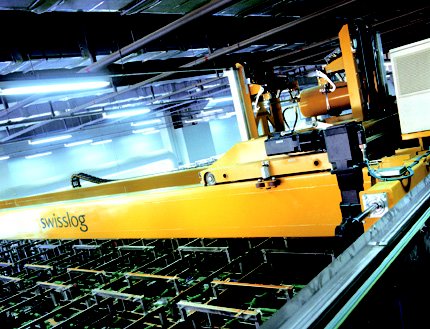Korean Air Flight Centre at the cutting
edge
Faster and more reliable service for airlines
Airport kitchens have to serve departing
flights under great time pressure. Besides handling food, drinks,
equipment and goods for sale, catering carts provide kitchens with their
own logistic challenge. After returning from arriving flights, catering
carts must always be emptied, washed, stored and refilled before being
delivered to departing flights again. The Swisslog Group companies Cimcorp
and Schierholz have jointly supplied Korean Air's new airport flight
kitchen at Incheon with an automated catering cart transportation and
buffer system.

|
Korean Air has built an airport kitchen at Seoul's new international Incheon
airport, where catering cart handling and buffering is completely automated.
Swisslog Groupís overhead conveyor supplier Louis Schierholz GmbH of Germany
had already supplied a number of catering facilities worldwide with
transport and buffer systems using conventional technology. Now, Cimcorp and
Schierholz have jointly developed and implemented a new concept for the
transportation and buffering of catering carts using an electric monorail
system (EMS) and a wide span gantry robot (GR). |
Hygiene and speed guaranteed
The core of the buffer system is a large gantry
robot supplied by Cimcorp. The catering carts, after having been stripped
of waste and washed, are stored on hangers in the robot's working area
until they are needed again.
The catering carts arrive in the working area
from the cart wash on hangers moving along the EMS supplied by Schierholz.
The robot picks the hangers and moves them to the buffer for storage from
where they are picked and unloaded according to the orders. A single order
always consists of all the catering carts needed for one flight. Once the
order is received, the robot picks the hangers from the buffer to meet the
order and moves them to the unloading station. From there, the hangers
again travel along the Schierholz EMS to different destinations for
refilling. Catering carts from various airlines are stored in the buffer
and, depending on the type of cart, one hanger can hold from 2 to 4 carts.
The capacity of the buffer totals 450 hangers. In one hour 70 hangers can
be moved in and 70 hangers can be moved out of the buffer. The catering
facility operates 18 hours per day and 351 days per year.
Since the catering carts are stored in hangers
under the gantry robot, no fixed structures are needed on the floor, which
would hinder cleaning. The floor area can easily be cleared and washed
whenever required. Another advantage of the overhead structures is that
the retrieval of the catering carts needed from the buffer happens
quickly. The robot gripper, having direct access, is able to pick hangers
from anywhere in the robot's working area within seconds.

|
Korean Air
eagerly grasped the opportunity to adapt the latest technology for their airport
kitchen. The concept developed by Cimcorp and Schierholz is unique in the
industry. |
Space-saving
Despite its extremely wide span,
the gantry robot as the heart of the buffer reduces the buffer space
requirements considerably compared with conventional solutions. The hangers
with the catering carts can be stored in two layers in the robot's working
area. The robot is equipped with an OPS-Box warehouse management system,
which controls the stock under the gantry robot according to the product
editor and the orders coming from the upper-level software. In
this way, trouble-free and reliable delivery of catering carts is
guaranteed. The software incorporates a storage optimization feature, which
facilitates effective utilization of the available space.

|
EKL Eastern Korea's Managing Director Alex Kim and the Assistant General Manager
of Korean Air's catering team, Mr. K.H. Kwak, familiarize themselves with the
catering cart buffer, which is ready for commissioning. Mr. Kwak appreciates the
excellent hygiene, speed and reliability provided by the gantry robot. |
(Sources from Cimcorp News 1/2001)


